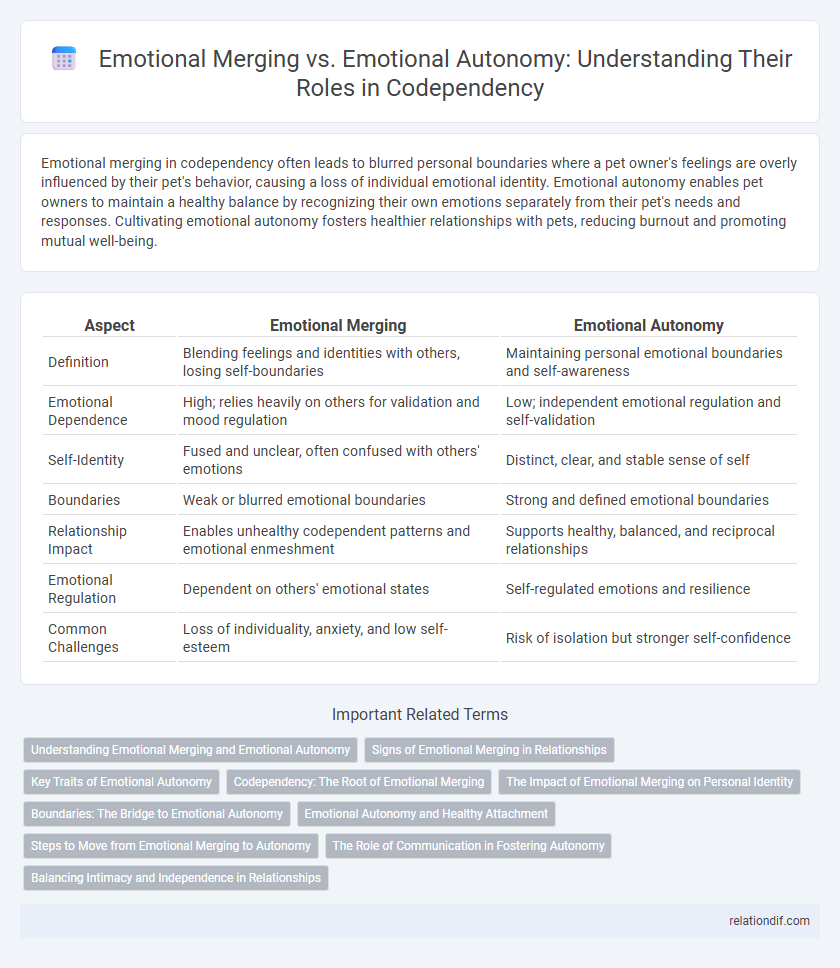Emotional merging in codependency often leads to blurred personal boundaries where a pet owner's feelings are overly influenced by their pet's behavior, causing a loss of individual emotional identity. Emotional autonomy enables pet owners to maintain a healthy balance by recognizing their own emotions separately from their pet's needs and responses. Cultivating emotional autonomy fosters healthier relationships with pets, reducing burnout and promoting mutual well-being.
Table of Comparison
| Aspect | Emotional Merging | Emotional Autonomy |
|---|---|---|
| Definition | Blending feelings and identities with others, losing self-boundaries | Maintaining personal emotional boundaries and self-awareness |
| Emotional Dependence | High; relies heavily on others for validation and mood regulation | Low; independent emotional regulation and self-validation |
| Self-Identity | Fused and unclear, often confused with others' emotions | Distinct, clear, and stable sense of self |
| Boundaries | Weak or blurred emotional boundaries | Strong and defined emotional boundaries |
| Relationship Impact | Enables unhealthy codependent patterns and emotional enmeshment | Supports healthy, balanced, and reciprocal relationships |
| Emotional Regulation | Dependent on others' emotional states | Self-regulated emotions and resilience |
| Common Challenges | Loss of individuality, anxiety, and low self-esteem | Risk of isolation but stronger self-confidence |
Understanding Emotional Merging and Emotional Autonomy
Emotional merging involves an excessive overlap of feelings and identities between individuals, often leading to blurred personal boundaries and a loss of self. Emotional autonomy, in contrast, emphasizes maintaining a distinct sense of self while engaging empathetically with others, fostering healthy relationships without dependency. Understanding the balance between emotional merging and emotional autonomy is crucial for recognizing codependent patterns and promoting emotional independence.
Signs of Emotional Merging in Relationships
Signs of emotional merging in relationships include a loss of personal boundaries where individuals prioritize others' feelings over their own, leading to dependence on partners for self-worth and decision-making. Frequent feelings of anxiety when apart, difficulty identifying personal emotions, and an overwhelming need for approval signal blurred emotional lines. Recognizing these patterns helps differentiate unhealthy emotional fusion from balanced emotional autonomy.
Key Traits of Emotional Autonomy
Emotional autonomy is characterized by self-awareness, healthy boundaries, and the capacity to regulate one's own emotions independently of others. Individuals with emotional autonomy possess resilience, maintain a clear sense of identity, and demonstrate emotional self-sufficiency, distinguishing them from codependent patterns involving emotional merging. Cultivating emotional autonomy enhances psychological well-being by promoting self-validation and reducing reliance on external approval.
Codependency: The Root of Emotional Merging
Codependency often leads to emotional merging, where individuals lose their sense of self by excessively relying on others for validation and identity. This blurred boundary undermines emotional autonomy, causing difficulty in setting personal limits and fostering unhealthy attachments. Understanding codependency as the root of emotional merging highlights the importance of reclaiming self-awareness and independence to establish balanced relationships.
The Impact of Emotional Merging on Personal Identity
Emotional merging often leads to blurred personal boundaries, causing individuals to lose their unique sense of identity and become overly dependent on the emotions of others. This fusion can hinder emotional autonomy, resulting in difficulty making independent decisions and maintaining self-awareness. Maintaining emotional autonomy is crucial for preserving personal identity and fostering healthy, balanced relationships.
Boundaries: The Bridge to Emotional Autonomy
Boundaries serve as the crucial bridge to emotional autonomy by clearly defining where one's emotions end and another's begin, preventing emotional merging that often leads to codependency. Establishing and maintaining healthy boundaries allows individuals to honor their own feelings without losing empathy for others, fostering self-awareness and personal growth. This separation supports emotional independence, enabling balanced relationships where both parties maintain their distinct emotional identities.
Emotional Autonomy and Healthy Attachment
Emotional autonomy involves maintaining a strong sense of self while forming healthy attachments that respect individual boundaries and foster mutual support. It enables individuals in relationships to express their needs clearly without losing their identity, promoting balanced interdependence rather than emotional merging. Cultivating emotional autonomy helps prevent codependent patterns by encouraging self-awareness, personal responsibility, and secure attachment styles.
Steps to Move from Emotional Merging to Autonomy
Establishing clear personal boundaries and practicing self-awareness are key steps to transition from emotional merging to emotional autonomy. Engaging in individual activities and fostering independent decision-making strengthen one's sense of self. Cultivating emotional regulation skills helps maintain a healthy balance between connection and individuality.
The Role of Communication in Fostering Autonomy
Effective communication plays a crucial role in fostering emotional autonomy by allowing individuals to express personal feelings and boundaries clearly while respecting others' emotions. Open dialogue reduces emotional merging by encouraging self-awareness and mutual understanding, which strengthens individual identity within relationships. Communication skills such as active listening and assertiveness help maintain emotional separation, preventing codependent patterns and promoting healthy interdependence.
Balancing Intimacy and Independence in Relationships
Balancing intimacy and independence in relationships involves managing emotional merging and emotional autonomy to foster healthy connections. Emotional merging occurs when personal boundaries blur, leading to excessive reliance on a partner for validation and identity, while emotional autonomy allows individuals to maintain self-awareness and personal growth within the relationship. Effective balance promotes mutual support and individual space, enhancing relationship satisfaction and psychological well-being.
Emotional merging vs Emotional autonomy Infographic

 relationdif.com
relationdif.com